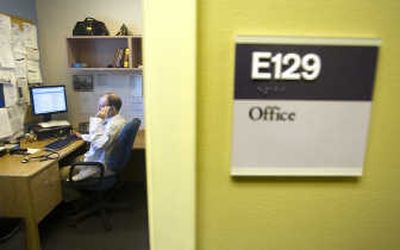Few physicians have embraced new medical technology

Todd Rubenstein scoots up to the examining table just as his doctor, Scott Maron, does something downright revolutionary in the world of private practice. He turns on his computer.
The doctor wants Rubenstein’s latest laboratory tests. Click.
He wants a chart trending the patient’s blood sugar and cholesterol levels. Click.
After some discussion, the doctor prescribes an anti-inflammatory to ease the recurring leg pain that brought the 41-year-lawyer to the doctor. Click.
“I see you use the CVS in Livingston,” Maron said. “Your prescription is there now.”
Maron, a Livingston, N.J., internist, represents something rarely seen in private medical practice today – a tech-savvy physician.
The average doctor’s office uses less technology than large-metro pizza parlors or video stores. Most physicians scribble prescriptions on pads and keep patient charts in stacks of manila folders.
A 2007 study by the U.S. government found a little more than 4 percent of medical practices use the latest technology to store health records. About 14 percent use some form of electronic record-keeping. And a bit more than 20 percent at least use e-mail to communicate with patients, according to a survey by the Center for Studying Health System Change, a Washington, D.C., think tank.
Government agencies and health advocacy groups have been pushing private-practice physicians to embrace technology to reduce mistakes and improve efficiency. Yet the effort has been slow-going.
“There’s benefit for patients; you can get children’s health forms, or get your medical records e-mailed quickly if you end up in the hospital or move out of state,” said Joy Grossman, a researcher at the Center for Studying Health System Change. “But for physicians there are downsides, like getting the technology to work the way you want.”
Doctors say they want to move into the high-tech world, but the transition is difficult and costly. They are not, after all, selling pizzas or renting movies. Information from patient histories, lab tests, medications and hospital reports can be massive and complex. Privacy, too, is an issue.
Maron said moving from paper to electronics was a serious investment of time and money – about $50,000, plus annual maintenance fees. He sees the advantages, though. If a patient undergoes a test in the morning, the results can be in the patient’s chart by noon.
In some cities, like Spokane, where doctors and clinics use shared medical records, the burden of keeping patients’ medical records up-to-date is much less complex. But few metro areas have the coordinated medical record system that Spokane now has, health care industry experts say.
While Spokane’s hospitals share patient information, that doesn’t mean most area doctors fully embrace technology in their daily practice.
The government wants more physicians to operate like Maron. Medicare soon will begin a demonstration project that pays $58,000 per physician and up to $290,000 per practice for 1,200 doctors to create electronic health records. Some private insurance companies have made similar offers. The U.S. Department of Health and Human Services has proposed standards for e-prescribing. These systems check for proper dosage and drug interactions and then let doctors e-mail prescriptions to pharmacies.
Yet barriers to change exist. The American Health Information Technology Community, a federal advisory body created in 2005, found that the greatest barrier to converting to electronic records is cost. Also, confronted with a myriad of systems, doctors must find the one that fits best with their practice. There also is fear that an expensive system will soon become obsolete, the advisory board found.
And then, there are those physicians who simply prefer doing it the old way.
One study found that 80 percent of patients would like to e-mail their physicians, but physicians largely avoid e-mail. Some doctors say they have privacy concerns, and they note that doctors do not get paid to answer e-mails.
Consumers, ultimately, will drive the change, said Joe Carr, chief information officer for the New Jersey Hospital Association. “If patients feel the people treating them are disconnected, then they will go somewhere else,” he said.